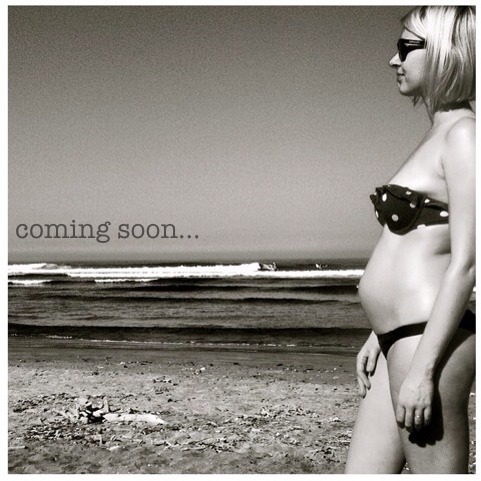Connection. Trust. Courage. Surrender. Beauty. Slow Down. Be Present. Laugh More. To the left you will find in-spirations, ex-halations and in-between, a journey. Always into the unknown.
Don't wanna be here? Send us removal request.
Photo

How do I know I’m in labor?
Very early signs:
"Nesting" - feeling an intense drive to tidy and clean and make a cozy home
You may lose your mucus plug (it’ll look like a giant lugey, and it might be a little bloody)
Period-poop. You thought that just cause you weren’t having your period you wouldn’t have to deal with the poop? Nope. You’re body’s clearing the way for that baby to use up all the space down there.
Your water might break. Only 2 out of 10 people have the movie-style pop-and-gush, and often enough the water doesn’t even break until you’re halfway through labor anyway, so don’t be surprised if that doesn’t happen or if all you get is a little, constant trickle of clear/brown/yellow/green fluid.
OK so now I’m in early labor? What’s next?
Contractions! I know that’s what you’ve been waiting for, and here they come. They’ll be irregular and you can still talk and walk through them. This stage can last anywhere from 2-20 hours, so be prepared. Eat, sleep, drink, go to the bathroom. Rest and give yourself the emotional space you need to prepare for labor.
Call your midwife, let her know, but stay home from the hospital/birth center as long as possible.
But how do I know that this is early labor, and not actual true-blue labor? Contractions during early labor: don’t stop you from talking, allow you to sleep in between, come irregularly, come once every 6 minutes or more, peter out when you walk.
Ok so now this is getting stronger. Can I go in to the hospital yet?
Wait to call your midwife until you have been having contractions that happen at least once every 5 minutes (once every 3 or 4 is even better) and have been doing so for at least two hours.
Then, see if you can wait even longer. Labor is often easier and moves quicker at home, so stick it out for as long as you feel comfortable.
Once you’re at the hospital/birth center/your midwife comes to your home, she may check your cervix if she believes you are in labor. At the hospital you’ll have your baby’s heart rate and your contraction pattern monitored for at least 20 minutes, and then they’ll decide if it’s time to admit you. Usually they’ll check you once when you first arrive and then again 2 hours later to see if your cervix is changing. If it isn’t, they may send you home! ��Don’t despair, it’ll happen eventually! Good luck <3
602 notes
·
View notes
Photo
What it looks like for some people in the middle of a contraction.

Thankyou, thankyou, thankyou for #blessing our space with your #love! #regram from @sunkap
19 notes
·
View notes
Photo

#gracefull #mama Lea-Ann Ellison is growing #strong at #crossfit. To quote her, “#pregnancy is not an illness!” Photo by #nickstern
54 notes
·
View notes
Photo

8 and a half months #pregnant. #gracefull #mamma Lea-Ann stays #strong at #crossfit . #photographer #nickstern
45 notes
·
View notes
Photo

8 months #pregnant = #motivation ! #pregnant #maternity #crossfit @crossfit
39 notes
·
View notes
Note
I've always wondered... Does the woman ever stink or smell when giving birth ? Like she's all there in the open.
When a woman gives birth this a natural ‘musky’ oder in the air, which comes from all the sweat glands. Check out this article for more info:
http://www.blogher.com/how-are-vaginas-supposed-smell
16 notes
·
View notes
Note
This blog helped me power though a fast and intense labor with my son born in May. I was induced at 8:30 in the morning, my water broke at 6:30 PMand I was at 4 cm, then he was born at 8:11PM. I couldn't get pain medication even if I wanted it but I pushed through and I really do think it was in part due to reading about and seeing so many wonderful births on this blog. thank you!
Hi There!! I've been gone for a while because I have been opening up my birthing center in Los Angeles. I'm so glad to hear you were inspired to trust your body and baby!!!
8 notes
·
View notes
Photo

#mamma, #dad, #sister, #baby AND #placenta all in the #birthingtub together! Yup, that’s how we roll at #gracefull! We love our #lotusbirth s!!! #midwife #midwifery #burbank #homebirth #naturalchildbirth #birthwithoutfear #waterbirth #family #instalove #childbirth @sunnyrowe
47 notes
·
View notes
Photo

Lol!!! @sunnyrowe #midwife #midwifery #pregnant
53 notes
·
View notes
Photo

WE HAD A BABY!
wow, what a wild ride… we could not have done it without our amazing midwife Elizabeth Bauchner from Gracefull Birthing. she enabled me to have litereally the most incredible experience of my life. i will be forever grateful.
xo
http://gracefullbirthing.com/
26 notes
·
View notes
Photo

This determined mother had a VBAC after a T-Incision cesarean birth! A hospital birth surrounded by love and support. The connection between her and her own mother had me in tears. The story, pictures and video are so moving.
More here:http://birthwithoutfearblog.com/2012/11/07/supported-vbac-after-t-incision-pictures-and-video/
70 notes
·
View notes
Video
youtube
By far, the funniest video I have seen a while!! I true Birth Junkie’s delight!!
74 notes
·
View notes
Photo



Top: Uterine lining at 5 1/2 months, displaying thin maternal separation from fetus, and high level of placental implantation Center: Relation of placenta to uterus at 5 weeks and 8.5 months Bottom: Major arteries and veins of the placenta
Did you know that the placenta is a temporary organ that’s actually created by the fetus, and not the woman?
The human female is a curious creature; like our close great ape cousins, but unlike almost all other mammals, they build up a thick barrier in the uterine wall, to protect against any potential embryo that might implant itself. When there’s no embryo implantation, the thickened wall is shed, in the process known as menstruation.
The thing is, most mammals don’t menstruate. They go into heat, and occasionally shed uterine lining (if the uterus is scratched, or an egg tries to implant but fails, for example), but there’s no regular cycle of bloody discharge relating to breeding. This is because other mammals go through triggered decidualization (developing a uterine lining only when a fertilized egg begins to implant itself), while the great apes (and a couple other convergently evolved families, including bats) experience spontaneous decidualization, where they develop a thick uterine lining during every ovulation, before an egg can even attempt to implant itself.
Why the different linings? Well, it turns out that there are three types of mammal placentas (remember, placentas are developed by the embryo/fetus, not the mother):
Epitheliochordal, which is completely superficial, and does not connect in any significant way to the mother’s body. The endometrial epithelium, connective tissue, and uterine epithelium are all preserved and undisturbed in the mother. The fetus is separated from the mother by three layers of tissue. Nutrients and waste are delivered and eliminated through diffusion, rather than direct connection. This group includes equids, swine, and ruminants.
Endotheliochordal, which is slightly more invasive to the mother, only preserves the uterine epithelium. Nutrients and waste are not exchanged through direct connection to the mother, but the placenta only leaves one layer of tissue between it and the mother. This group includes cats and dogs.
Hemochorial is the most invasive form of placenta in the animal kingdom. The embryo directly hooks itself up to the host (mother’s) blood flow, and leaves no tissue layers between the female and the placenta. This allows much more efficient nutrient transfer to the embryo or fetus, but is also potentially the most harmful to the female since the embryo attaches itself so securely to the uterine wall. The female must develop preemptive measures (a thickened uterine lining) to protect herself from a life-form that is literally driven to take all of the nutrients it needs to develop, and which has adapted to connect itself directly to the host. This group includes elephant shrews, most bats, and most primates.
Interested in more about the science behind reproduction and how amazingly efficient the human embryo is at sucking its host clean, just to obtain its needed resources for development?
PZ Meyers at Pharyngula has an understandable explanation of the article I referenced for this post.
There is also a great site by R. Bowen about the pathophysiology of the reproductive system.
An American Text-Book of Obstetrics for Practitioners and Students. Edited by Richard C. Norris, 1895.
2K notes
·
View notes



